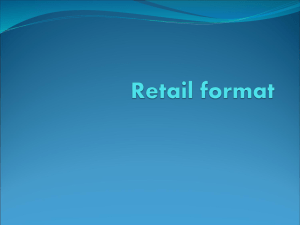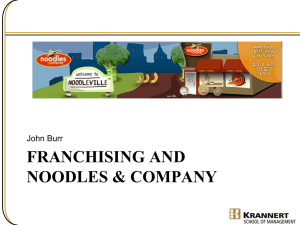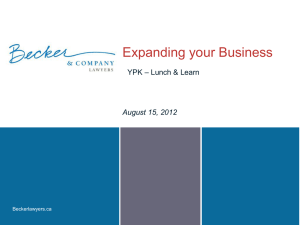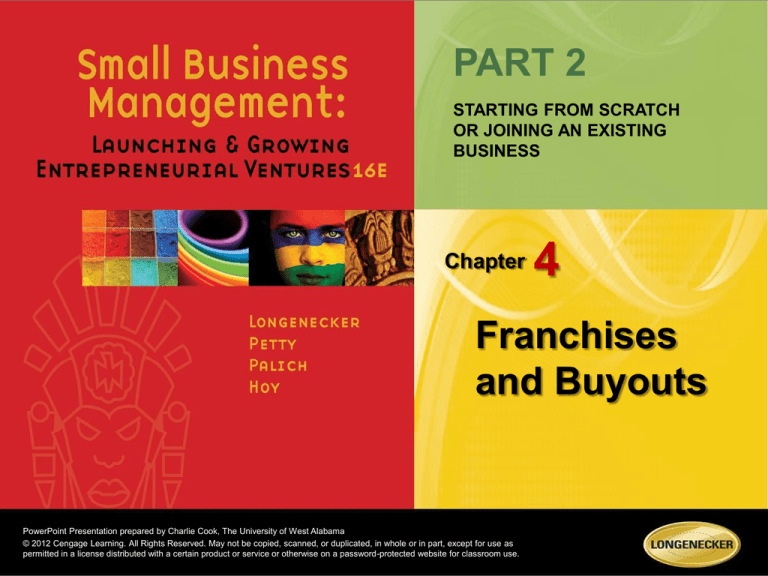
PART 2
STARTING FROM SCRATCH
OR JOINING AN EXISTING
BUSINESS
Chapter
4
Franchises
and Buyouts
PowerPoint Presentation prepared by Charlie Cook, The University of West Alabama
© 2012 Cengage Learning. All Rights Reserved. May not be copied, scanned, or duplicated, in whole or in part, except for use as
permitted in a license distributed with a certain product or service or otherwise on a password-protected website for classroom use.
1. Define franchising, and become familiar with franchise
terminology.
2. Understand the pros and cons of franchising
and the structure of the industry.
3. Describe the process for evaluating
a franchise opportunity.
4. List four reasons for buying an existing
business, and describe the process for
evaluating a business.
© 2012 Cengage Learning. All Rights Reserved. May not be copied, scanned, or duplicated, in whole or in part, except for use as
permitted in a license distributed with a certain product or service or otherwise on a password-protected website for classroom use.
© iStockphoto.com/Dan Bachman
After studying this chapter, you should be able to…
4–2
What Is Franchising?
• Franchising
A marketing system involving a legal agreement,
whereby the franchisee conducts business according
to the terms specified by the franchisor.
• Franchisor
Party in franchise contract that specifies methods to
be followed and terms to be met by the other party.
• Franchisee
An entrepreneur whose power is limited by a
contractual agreement with a franchisor.
4–3
Franchising Terminology
• Franchise Contract
The legal agreement between franchisor and
franchisee
• Franchise
The privileges conveyed in the franchise contract
4–4
Franchising Options
Product and Trade
Name Franchising
Area
Developers
Business Format
Franchising
Piggyback
Franchising
Master
Licensee
Multiple-Unit
Ownership
Types of
Franchising
Arrangements
Multi-Brand
Franchising
Co-Branding
4–5
EXHIBIT 4.1
Economic Impact of Franchising
Economic Activity in Franchised Businesses
There were estimated to be 901,093 establishments in franchise systems in the
United States in 2010.These businesses directly provided
• 9.558 million jobs
• output worth $868.3 billion.
These businesses accounted for approximately 3 percent of all U.S. business
establishments. During the economic turmoil in the United States from 2007 to
2010,employment in eight of ten lines of franchise business activity increased. The
two exceptions were Commercial and Residential Services and Lodging.
Economic Activity Because of Franchised Businesses
According to the most recent economic impact study by PriceWaterhouseCoopers,
the economic significance of franchising is greater than indicated by the activity in
franchised businesses alone, for it stimulates still more activity and causes growth in
many nonfranchised businesses. Counting economic results both inside and outside
of franchising, franchised businesses in the United States were the cause of
• 21 million jobs, or 15.3 percent of private-sector jobs
• $660.9 billion of payroll, or 12.5 percent of private-sector payrolls
• $2.31 trillion of output, or 11.4 percent of private-sector output.
Sources: PriceWaterhouseCoopers, 2010 Franchise Business Economic Outlook (Washington, DC: International Franchise Association, 2010); and
PriceWaterhouseCoopers, The Economic Impact of Franchised Businesses, Volume II (Washington, DC: International Franchise Association, 2008).
© 2012 Cengage Learning. All Rights Reserved. May not be copied, scanned, or duplicated, in whole or in part, except for use as
permitted in a license distributed with a certain product or service or otherwise on a password-protected website for classroom use.
4–6
The Pros and Cons of Franchising
• Advantages
Probability of success
Proven line of business
Pre-qualification of
franchisee
Training Support
Franchisor-provided
Financial assistance
Franchisor assistance
Operating benefits
Franchisor-aided
• Limitations
Franchise costs
Initial franchise fee
Investment costs
Royalty payments
Advertising costs
Restrictions on
business operations
Loss of independence
Lack of franchisor
support
4–7
EXHIBIT 4.2
Advantages of the Franchise Model
• Reduced risk of failure
• Going into business for yourself, but not by yourself
• Use of a valuable trade name and trademark
• Access to a proven business system
• Management training provided by the franchisor
• Immediate economies of scale
• A way for an existing business to diversify
© 2012 Cengage Learning. All Rights Reserved. May not be copied, scanned, or duplicated, in whole or in part, except for use as
permitted in a license distributed with a certain product or service or otherwise on a password-protected website for classroom use.
4–8
EXHIBIT 4.3
Government Concerns About Franchising
1. Misleading or exaggerated earnings claims by franchisors
2. Opportunity behavior by which the franchisor becomes a competitive threat to
franchisees
3. Restrictions on franchisees who desire to liquidate their holdings in favor of
alternative investment opportunities
4. Conflicts of interest, such as when a franchisor forces franchisees to be captive
outlets for other suppliers owned by the franchisor
5. Churning: terminating a successful franchise operation in order to resell it and gain
additional franchise fees
6. Encroachment: locating a new outlet or point of distribution too close to an existing
franchisee, causing a material loss of sales
7. Imposing noncompete clauses on franchisees
8. One-sided contracts devised by franchisors
9. The imposition of new restrictions as a requirement of contract renewal
10. Franchisor intimidation of franchisees who attempt to form franchisee associations,
seek alternative sources for products, or make other efforts to create a more level
playing field
© 2012 Cengage Learning. All Rights Reserved. May not be copied, scanned, or duplicated, in whole or in part, except for use as
permitted in a license distributed with a certain product or service or otherwise on a password-protected website for classroom use.
4–9
EXHIBIT 4.4
An Estimate of Investment Costs and Benefits
by Oreck Clean Home Center
© 2012 Cengage Learning. All Rights Reserved. May not be copied, scanned, or duplicated, in whole or in part, except for use as
permitted in a license distributed with a certain product or service or otherwise on a password-protected website for classroom use.
4–10
Franchisor Controls on Franchisees
• Restricting of sales territory
• Requiring site approval and imposing
requirement on the outlet’s appearance
• Restricting the goods/services that can be sold
• Requiring specific operating hours
• Controlling advertising
4–11
Evaluating Franchise Opportunities
• Selecting a Franchise
Personal observation
Advertisements
• Investigating the Potential Franchise
Information sources
Independent, third-party sources
– Federal Trade Commission
– Internet
– Franchise consultants
Franchisors themselves
– Disclosure documents
Existing and previous franchisees
4–12
EXHIBIT 4.5
Evaluating Franchise Opportunities
1. Is the franchisor dedicated to a franchise system as its primary
mechanism of product and service distribution?
2. Does the franchisor produce and market quality goods and
services for which there is an established market demand?
3. Does the franchisor enjoy a favorable reputation and broad
acceptance in the industry?
4. Will the franchisor offer an established, well-designed marketing
and business plan and provide substantial and complete training to
franchisees?
5. Does the franchisor have good relations with its franchisees, and
do the franchisees have a strong franchisee organization that has
negotiating leverage with the franchisor?
6. Does the franchisor have a history of attractive earnings by its
franchisees?
© 2012 Cengage Learning. All Rights Reserved. May not be copied, scanned, or duplicated, in whole or in part, except for use as
permitted in a license distributed with a certain product or service or otherwise on a password-protected website for classroom use.
4–13
EXHIBIT 4.6
Profile from International Franchise Association (2010)
© 2012 Cengage Learning. All Rights Reserved. May not be copied, scanned, or duplicated, in whole or in part, except for use as
permitted in a license distributed with a certain product or service or otherwise on a password-protected website for classroom use.
4–14
EXHIBIT 4.6
Profile from International Franchise Association (2010)
Source: http://franchise.org/Glass_Doctor_franchise.aspx, accessed October 26, 2010.
© 2012 Cengage Learning. All Rights Reserved. May not be copied, scanned, or duplicated, in whole or in part, except for use as
permitted in a license distributed with a certain product or service or otherwise on a password-protected website for classroom use.
4–15
EXHIBIT 4.7
Top 10 Fastest Growing Franchises for 2010
Name/Rank
Startup Costs (2009)
1. Jan-Pro Franchising Int’l. Inc. Commercial cleaning
$3,145–50,405
2. Subway
Submarine sandwiches and salads
$84,300–258,300
3. Stratus Building Solutions
Commercial cleaning
$3,450–57,750
4. Dunkin’ Donuts
Coffee, doughnuts, baked goods
$358,200–1,980,300
5. Anago Cleaning Systems
Commercial cleaning
$8,543–65,406
6. McDonald’s
Hamburgers, chicken, salads
$1,057,200–1,885,000
7. CleanNet USA Inc.
Commercial cleaning
$6,655–92,950
8. Bonus Building Care
Commercial cleaning
$9,020–41,919
9. Liberty Tax Service
Individual and online tax preparation
$56,800–69,900
10. Vanguard Cleaning Systems
Commercial cleaning
$8,200–38,100
Source: Entrepreneur's 2010 Fastest-Growing Franchises Rankings (Top 10) with Start-Up Cost Ranges in 2009 from http://www.entrepreneur.com,
accessed October 29, 2010. Reprinted with permission of Entrepreneur Media, Inc. © 2010 by Entrepreneur Media, Inc. All rights reserved.
© 2012 Cengage Learning. All Rights Reserved. May not be copied, scanned, or duplicated, in whole or in part, except for use as
permitted in a license distributed with a certain product or service or otherwise on a password-protected website for classroom use.
4–16
Becoming a Franchisor
The Business
Model
Financial
Considerations
Required
Assistance
Franchisor
Considerations
Operations
Manual
Development
Government
Regulations
Adding Long-Term
Value
4–17
Becoming a Franchisor
• Benefits
• Drawbacks
Reduction of capital
Reduction in control
requirements
Increase in
management
motivation
Speed of expansion
Sharing of profits
Increase in operational
support costs
4–18
Legal Issues in Franchising
• The Franchising Contract
Signed with legal counsel present
Contains a termination and transfer provision
Contains statement of rights to renew contract
4–19
Franchise Disclosure Requirements
• Rule 436 of the Federal Trade Commission
A rule that prescribes that the franchisor must
disclose certain information to prospective
franchisees
http://www.ftc.gov/bcp/edu/pubs/business/franchise/bus70.pdf
Franchise Disclosure Document (FDD)
A document accepted by the Federal Trade Commission as
satisfying its franchise disclosure requirements
– Investment requirements
– Conditions that would affect renewal, termination, or sale
of the franchise
4–20
Buying an Existing Business?
Reduction of
Uncertainties
of Startup
A Bargain
Price
Acquisition of
Ongoing Operations
and Relationships
A Quick Start
4–21
Finding a Business to Buy
1.
2.
3.
4.
Determine your commitment.
Establish what you can afford.
Figure out what skills you have.
Consider lifestyle impact.
© 2012 Cengage Learning. All Rights Reserved. May not be copied, scanned, or duplicated, in whole or in part, except for use as
permitted in a license distributed with a certain product or service or otherwise on a password-protected website for classroom use.
4–22
Pros and Cons of Buying
an Existing Business
• Pros
• Cons
High chance of success
Existing problems
Less planning
Poor quality of current
Existing customers/
employees
Poor business image
Modernization required
Purchase price based
on inaccurate data
Poor business location
suppliers
Necessary equipment
Bargain price
Experienced employees
Existing business
records
4–23
Finding a Business to Buy
• Due Diligence
The exercise of the prudence expected of a
reasonable person in the careful evaluation
of a business opportunity.
• Matchmakers
Specialized brokers that bring
together buyers and sellers
• Relying on Professionals
Accountants
Attorneys
Other experienced business owners
4–24
EXHIBIT 4.8
Due Diligence for Purchasing a Business
Once you’ve found a business that you would like to buy, it’s important to
conduct a thorough, objective investigation. Look into every aspect of the
business, verifying whether the owner’s stated reasons for selling are
legitimate and double-check every detail for accuracy. The following list
includes important information you want to include when researching the
business you want to buy.
1. Contracts and lease agreements
10. Advertisement materials
2. Financial statements
11. Inventory receipts/lists
3. Tax returns
12. Organization charts
4. Real and personal property documents
5. Bank accounts
13. Payroll, benefits, and employee
pension/profit sharing info
6. Customer lists
14. Employee roster
7. Sales records
15. Certification by federal, state or
local agencies
8. Supplier/purchaser list
9. Contracts
16. List of owners
© 2012 Cengage Learning. All Rights Reserved. May not be copied, scanned, or duplicated, in whole or in part, except for use as
permitted in a license distributed with a certain product or service or otherwise on a password-protected website for classroom use.
4–25
Finding Out Why a Business Is For Sale
• Owner’s Reasons for Selling
Old age or illness
Desire to relocate in a different section of the country
Decision to accept a position with another company
Unprofitability of the business
Loss of an exclusive sales franchise
Maturing of the industry and lack of growth potential
• Beware of sellers who may have “cooked the
books” to make the business more attractive.
4–26
Examining the Financial Data
• Review financial statements and tax returns for
the past five years.
• Recognize that financial data can be misleading.
Assets overvalued
Expenses overstated/understated
Income underreported
Unrecorded debts
• Adjust asset valuations to reflect the true state of
the business (fair market value).
4–27
Valuing the Business
• Asset-Based Valuation
Estimates the value of the firm’s assets; does not
reflect the value of the firm as a going concern.
• Market-Comparable Valuation
Considers the sale prices of comparable firms;
difficulty is in finding comparable firms.
• Cash-Flow-based Valuation
Compares the expected and required rates of return
on the amount of capital to be invested in the
business.
4–28
Nonquantitative Factors
in Valuing a Business
• Competition
• Market
• Future community
development
• Legal commitments
• Union contracts
• Buildings
• Product prices
4–29
Negotiating and Closing the Deal
• Terms of Purchase
Assets purchase or total entity
Indemnification clause
Payment in full or partial payments over time
• Closing the sale
Best handled by a third party
Bill of sale
Tax certifications
Payment-to-seller agreements
and guarantees
4–30
Key Terms
•
•
•
•
•
•
•
•
•
•
franchising
franchisor
franchisee
franchise contract
franchise
product and trade name
franchising
business format
franchising
master licensee
multiple-unit ownership
area developers
•
•
•
•
•
•
•
•
•
•
•
piggyback franchising
multi-brand franchising
co-branding
churning
encroachment
Franchise Disclosure
Document (FDD)
Franchise Rule
matchmakers
due diligence
nondisclosure agreement
fair market value
© 2012 Cengage Learning. All Rights Reserved. May not be copied, scanned, or duplicated, in whole or in part, except for use as
permitted in a license distributed with a certain product or service or otherwise on a password-protected website for classroom use.
4–31






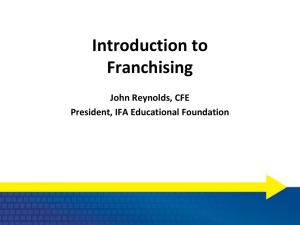
![[10]. Accessing Resources for Growth from External Sources](http://s2.studylib.net/store/data/005546472_1-5ce4dc20e590c3a704ef63f6f22a5a81-300x300.png)
